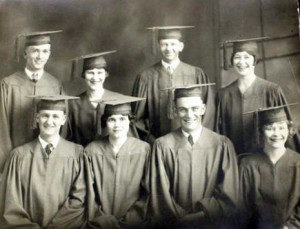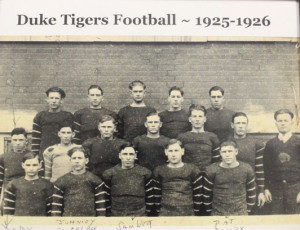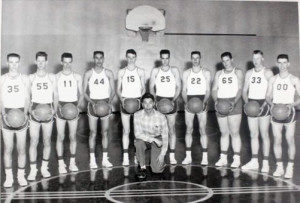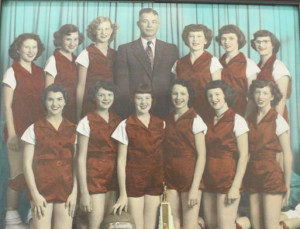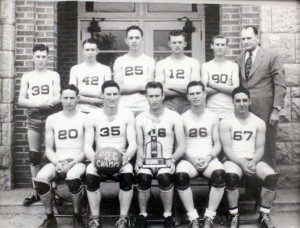A FIRST IN OKLAHOMA: THE UNDERGROUND SCHOOL
It was every child’s secret fantasy and every school administrator’s nightmare. On April 9, 1964 as the cry “Fire!” echoed throughout the halls of the Duke school, this small community in southwest Oklahoma was faced with reconstructing the entire facility. However, with the students safe and smoke still pouring from the rubble, it was first necessary to find a temporary location in which to finish classes for that year. The unharmed lunch room, bus shed, and community churches provided make-shift space for learning that spring.
Immediately following, plans were made to rebuild a permanent school in this progressive community. The late Mr. D. L. Boyer, superintendent at the time, spent many months of travel, study an planning for the construction of the new school. After visiting and underground school building in Artesia, New Mexico, it was decided that such a structure was feasible for Duke
The school which was occupied on August 16, 1965 contained 2300 square feet of floor space, including 15 classrooms, 2 offices, 4 restrooms, a cafetorium, a work room, and a mechanical room. The architect for the project was William Appleby Jr. of Altus. The contractor was Cuthbert and Hall of Elk City. The final cost of the building was $280,418.00 or $12.19 per square foot. However, a year later a gym was added above ground at and additional cost of $81,870.38.
The facility provides excellent shelter from tornadoes and nuclear fallout, as well as being completely fireproof. It has a capacity of 1950 people and a protection factor of 300. Emergency generators complete its safety features.
The underground design offers a number of advantages which include more compact floor plans, fewer distractions from outside noise, and reduced maintenance and energy costs. Also, lighting is controlled, making darkness easily obtainable for projector usage. In addition, air flow is regulated and consists of 40% fresh air and 60% recirculated air which is kept in constant motion. This greatly reduces allergy problems.
Currently the 20 year old building remains in excellent condition. The present superintendent, Mr. Bill E. Morgan invites anyone in the area to tour the school.
This article was written and submitted by Robetha Masters Darby, a graduate of the Duke High School in 1965. She is presently teaching mathematics at the Duke School (current enrollment 144) where she has been employed the previous 9 years.
The A.L. Perry family crossed the Red River from Texas on a bridge made of bales of straw. They settled 12 miles west of the present town of Altus on the banks of Turkey Creek. Mr. Perry made an application for a charter post office. The office was called Duke after a Mangum judge Mr. F.B. Duke. Perry was the first post master. Mrs. Perry said it would be the “duke” of the prairie.
In about 1908 when word came about a railroad passing through the community a new township was started. Duke’s people became divided. Many homes and businesses were moving to the New Town. (It was only ¼ mile East of the Old Town) Even the churches moved into an area called “No man’s land” to be able to serve the entire community. One story was told that the new railroad depot was built in the new town but moved westward to No man’s land. Since it was on rail wheels, one group moved the depot back to the new town in the middle of the night only to have it returned the next morning.
The Duke Schools was located about ½ mile south of the present town. A bond issue was presented to the town in 1910 to replace the old 3 room frame building but the community was so divided that it didn’t pass. Another election was held and a new building was built in the new town. The old town of Duke quickly went to work and built their own school. The two schools were less than ¼ mile apart.
The first Duke Schools system (grades 1-8) was organized in 1900 with Mrs. Dora Stuart as superintendent. She later became head of the history department at Southwestern Okla. State Univ. at Weatherford. G.R. Phelps was the first child to enroll.
The first attempt to “grade” the Duke school was in 1910. The high school was added at this time and accredited in 1913. Walter P. Marsh and Hubert Blassingame were the first 2 graduates.
In 1921, New Line District No. 34 was joined to Duke School. Trucks were used to gather the children and take them home at the close of the day. A gymnasium-auditorium was also added. In 1922 the Jackson county Class “A” Football Championship was achieved and added to their record after only one season. Just two men, Clemmons Brothers, had ever played the game of football before. The team scored a total of 243 points in 9 games holding their opponents to only 70 points for the entire season. Elmer Beck, Clemons, Maples, Roberson, Rose, Smalling, Fewell, Vunningham, Darby, Weimhod, Dickerson, and Smith were team members. Elmer Beck is now our eldest living graduate of Duke School.
With new school unity and the strengthening of the town many fine families moved to the area. In the early 1900’s Duke boasted of these businesses: 1 bank, 2 dry goods stores, 4 grocery stores, 1 department store, 2 drug stores, 1 meat market, 1 hotel, 3 restaurants, 2 grain feed and poultry houses, 1 lumber yard, 4 coal dealers, 2 elevators, 3 cotton gins, 2 blacksmith shops, 3 barber shops, 1 tailor shop, 2 garages, 5 service stations, and 1 newspaper.
The struggle between the settlement of the township finally came to an end after more than 7 years. A strange ceremony would signal the end. A horse drawn hearse carrying a bloody hatchet was brought near the present day bank. The hatchet was the symbol of the division of the community. A grave was dug and the hatchet buried. The leaders of the old town and the new town shook hands over the grave. In a short time, the original township was deserted.
North of Duke another fine school begun. Rock school also called Bynum Schools was also a victim of the strife of the times. The original frame building was built of rock to keep from being burned.
South of Duke a school was located at Cottonwood near the present site of Cottonwood Cemetery. It made a couple of moves Southward before being permanently located and changing its name to tony Point. In 1937 became part of Duke School. Mr. and Mrs. E.F. Walder were teachers there then.
Prairie Hill School was erected before Duke School in 1891. It was the first school in Jackson County to have a brick building which was later destroyed by a tornado.
Grand View and Lee Summit schools were ward schools that closed to have their elementary school students transferred to Prairie Hill. Prairie Hill Schools became part of Duke School. Victory and Centralvue consolidated.
In 1911 there were only 78 students in Duke School in Grades 1-9. Since then the enrollment has risen and fallen to many numbers over the years.
The second school building was constructed in 1911 and torn down in 1936.
D.L. Boyer, the 27th superintendent, came to Duke School in 1962. During the time he was superintendent, Duke School burned for the second time, April 9, 1964. After many months of travel, planning and construction, Dr. Boyer’s dream of an underground school became a reality. The present building, the first underground school in Oklahoma was occupied in August 16, 1965.
August 1969 marked an end to the fall cotton pulling break in classes for Duke School. Since then Duke school has developed into a fine institution for college bound graduates.
As Cecil R. Chesser stated: “We were happy then and we were thankful. It was not an artificial thankfulness but was so spontaneous and straight from our hearts that were not even aware we were thankful. We were, I believe, what God wants all men to be – natural, real, unadorned and unblemished by hypocrisy, fully aware of our blessings brought about by honest efforts of hard labor. I do not know if it will ever be that way again.”
OKLAHOMA’S FIRST COMPLETELY UNDERGROUND SCHOOL NEAR COMPLETION
Duke, Oklahoma is well underway to having the first completely underground school plant in the state. Duke’s Board of Education, after careful research and deliberation, gave its approval to go underground last summer, and the new school is expected to be ready in July of this year.
Although underground schools are still very unique, Duke’s will not be entirely new to the state. Custer City has an underground structure, an addition to the old school which houses three classrooms.
A new school at Duke became necessary after fire wiped out most of the communities’ education facilities in April of 1964. Funds for building the new school will come from $155,000 in bonds voted by the district and $110,000 from insurance carried on the old school.
Plans call for 15 rooms of the new school to be underground. The gymnasium, the superintendent’s office and a board room and mechanical room will later be built above ground.
Why an underground school? Duke school officials say there are a number of reasons, but two prime ones. “First, it will serve as a fallout shelter and will provide protection for children. Secondly, it can be used as a storm cellar in case of a tornado and other storms.”
To make sure an underground school would be satisfactory, Duke’s Board of Education, consisting of E.W. Beck, Paul Baird, Parker Brawley, Alvin Robertson, and Roland Hall, all visited the first such school in Artesia, New Mexico. The board members came away impressed, and evidently Duke school patrons are in agreement. Nearly every eligible voter turned out for the school bond election and the issue was approved 187 to 0. Many residents of Duke have expressed their favor for the underground school and boys and girls who will be using it are 100 percent for attending classes beneath the surface of the earth.
School officials point out that there will be more comfort for those using the building and utility bills will be lower for the underground structure than for a conventional building. Like a cellar, the building will automatically provide some warmth in the winter months and in late spring and early autumn, it will be cooler than a building atop the ground.
Electric lights will have to be on when the building is in use, but this is normally the case in other type structures. It is estimated that the schools district’s utility bills will be cut in half with the underground school. Cost factors can be reduced, because in terms of unit cost, the windowless schools, even with sprinkler systems and air conditioning, have been operated for less than conventional schools in most localities. Once requirements for daylighting are eliminated, it becomes possible to use very compact plan arrangements. This results in a reduced area of exterior walls and shorter lines of travel from one part of the building to another and to exits. The underground location tends to reduce heating and cooling requirements and operation costs of the mechanical system. Since the building is protected from the weather, very little outside maintenance is necessary.
Another factor Duke citizens appreciate is that it will be completely fireproof, except for furniture. Two Duke School building have been lost in the past because of fires.
Less noise and distractions from outside was another selling factor to the Duke people. In addition, audiovisual education equipment will work better in the underground rooms because of the ready-made darkness. Also, there will be less dust and other matter in the air, cutting down on the causes of allergies.
Based on recent Oklahoma building, estimated construction costs of underground schools are $11.65 per square foot as compared to $13.85 per square foot for a similar school above ground.
Construction of the new building in Duke will be on the same site as the burned out structure. In addition to the classrooms, there will be a cafetorium, (This is where programs will be staged, in addition to its use as an eating facility.)
Four feet of the underground portion will be above ground. The ground will be sloped up to the sides in the landscaping of the area. The underground portion will be eight feet in depth. For getting to the “downstairs” rooms there will be two stairways, a ramp and a service elevator.
Approximately 250 students are expected to use the Duke school facilities next year and all 12 grades will be housed in the new building. The building will be constructed so rooms can be erected above the underground portions if and when needed.
An interim report on a research study currently being conducted in Artesia, the school Duke’s board of education visited, proves interesting. The study information is taken from a pamphlet distributed by the Oklahoma Civil Defense, pointing out the feasibility for underground structures to be used both a school and shelter. The study says:
- Elementary school fallout shelter environment is an adequate environment in which the achievement tasks of elementary school children can be met.
- The underground school fallout shelter environment did not adversely affect the group processes, motivational attitudes or personal adjustment of the pupils.
- Neither the school anxiety nor the general anxiety of elementary school children attending school fallout shelter structures is increased by the type of facility they attend.
- An underground school fallout shelter environment does not affect attitudes or anxiety of elementary school teachers teaching in that environment.
- The vast majority of teachers teaching in windowless and underground environments favor the absence of windows in elementary classrooms and feel their teaching effectiveness is greater because of the absence of windows.
- School nurses report that, in their opinions, and according to reports of physicians, the transfer of asthmatic pupils to the underground school environment resulted in better attendance records for such pupils.
Mr. Ross, principal of Abo Elementary School and fallout shelter in Artesia, has made the following statements concerning the underground emotional effects. “The question has been raised by some as to the emotional or psychological effects on children, and adults, in working and going to school underground. It is my observation and belief that there have been no ill effects on any students or teachers who have attended the Abo Schools during this past year, its first year of operation. I do not believe there are any discernable differences – no more fears or anxieties – between students and teachers at the Abo school and those in other elementary schools in the Artesia School District.”
“I believe that I can truthfully say that all of the teachers and students like the Abo School and have enjoyed working and attending school there. I believe, also, that the great majority of parents in the Artesia School District have approved of the school and its operation. This is borne out by the fact that the Artesia School District is planning to construct a new junior high school entirely at the district’s expense, that will have classrooms underground which can double as a civil defense shelter. On the basis of my experience in working in the Abo Elementary School and fallout shelter, I strongly recommend the dual purpose public building-shelter as a practical economical method of providing emergency shelters.”
Also from the Oklahoma Civil Defense pamphlet is this statement by H. C. Brantley, school superintendent, concerning local reaction to the Laredo, Texas underground school.
“I cannot begin to describe the student and faculty reaction to the underground structure. The people were overwhelmed with the practicality, beauty and comfort which it affords them. The parents feel the same way. The City of Laredo as a whole seems to be astonished about the building. The news media has been most active in its coverage of the structure and all comment has been favorable. The overall reaction has been most satisfying to the Board Members and they are exceptionally proud of the building and the fact that they have contributed to the fallout protection of the area.
As an educator, I can state that the facility is a most functional educational tool. It provides a controlled environment most conductive to presenting informational material. Also, I am happy to see there has been no evidence of the students being adversely affected by the fact they are underground in a fallout protected facility. There is no effect of being cramped or crowded in the facility. Before we moved the students in, we put mirrors on the walls in corridors and stairwells. This gives a feeling of openness. Also, this way they always see a lot of people and if one student is walking down the corridor he sees himself.
Before we installed the emergency generator we had one power failure which we did not expect. Of course, it was dark as could be, but we did not encounter any difficulty whatsoever on the part of the children. The Principal told them what to do over the PA system and the teachers led the children, holding each others hands, upstairs. They showed absolutely no sign of panic.”
The Centralvue district, just north of Duke, lost its school last year and Duke students have been using the vacant facilities until their new school is completed.
From then on, Duke students and parents firmly believe they will “step up” education by “stepping down” to go to school.
A SHORT HISTORY OF THE DUKE SCHOOL
By Sonny Rotan
On Opening the box taken from the cornerstone of the building that burned on April 9, 1964 the following history of the Duke School was found. The box was opened October 22nd, 1965 in the Cafetorium of the Underground school.
Duke organized its’ first school system, which was made up of only eight grades, in 1900 under supervision of Mrs. Dora Stuart, who is now head of the history department at Southwestern State College of Diversified Education.
The old school was located about a half mile south of Roberson’s garage, and its first enrollee was Mr. G.R. Phellps who is now a prominent citizen of Duke.
The second school building was constructed in 1911 close to the one which is now underway. W.T. Clark was superintendent at that time. This building was torn down in 1936.
It was in 1913 that Duke was accredited with a high school. Embry West was Superintendent at that time. The first two graduates of this high school were Walter P. Marsh and Hubert Blasingame, respectively.
Duke has admitted twenty-two superintendents to its school system since its origin in 1900. Following are the superintendent’s names in order that they taught.
Miss Dora Stewart, the first superintendent, resides in Weatherford Oklahoma, where she is head of the history department in Southwestern State College of Diversified Occupations.
Mr. J.E. Drigger, the second superintendent, was last heard from in Oklahoma City.
Mr. E.E. Dale, is now head of the history department at the University of Oklahoma. He is the author of the text book which the ninth is now using.
The next two superintendents, Mr. J.E. Taylor and Mr. J. C. Counts, are lawyers in Oklahoma City.
The sixth superintendent, Mr. Thomas, was head of the school in Duke for one term. His present whereabouts are not known.
Mr. Rozch, deceased, was the seventh superintendent, and followed by Mr. Paul Summers.
Mr. L.R. Lowry, a former Duke citizen, taught in the school system in 1910 and was followed by W.T. Clark, deceased, who was one time county superintendent of Jackson County. He held office from 1915 to 1919.
The next superintendents appear in order in which they taught; Embry West; L.R. Lowry (re-election); V.I. Bandy; J.H. Taylor; Richard L. McLean; Mr. J.W. Dungan; Grover C. (Pete) Montgomery, who finished out the term of Mr. Dungan, who had died of a heart attack; Mr. B.M. Skidmore; Buford Minor; Paul Salman; and Mr. O.E. Hatcher.
Our present superintendent is Mr. J.D. Motsenbocker, who came here in 1939 and has already been asked back for the coming year.
October 23, 1965 Duke School History Continued:
After J.D. Motsenbocker left, Sammie Spraggins became superintendent, remaining only for the summer session, and left to enter defense work. Grover McCutcheon completed the year and remained until 1947.
Elvoy Owens was the next Superintendent, but had to resign in his second year because of ill health and E.F. Walker, the Principal, took the position and remained five years.
The next Superintendent was Ronald Carpenter, who remained nine years.
The present Superintendent, D.L. Boyer, joined the school system in 1962. On April 9th, 1964, for the second time, we lost a school building by fire. After many months of travel, planning and construction, Mr. Boyer’s dream of and Underground School became a reality. The present Building, the First Underground School In Oklahoma, was occupied August 16, 1965.
The following lists of names were copied from handwritten lists which had the date of November 3, 1911. These were contained in the box taken from the cornerstone of the building that burned on April 9, 1964. The box was opened October 22, 1965, in the Cafetorium of the Underground school.
Primary Grades 1, 2, and 3 – Teacher Bessie Woodard
Jewel Henry Annie M. Powell
Kate Hessler M.C. Powell
Jesse Craig Hubbard McBride
Merlin Craig Gladys McBride
Eva Buchanan Nettie Lou Phelps
Loyas Buchanan D. Land Morgan
Voorheis Wilson May Nelson
Sampie West Gladys Nelson
Maud Stevenson Irene Hefner
Bertha Stevenson Bacil Dowdy
Ralph Stevenson Homer Dowdy
William Heidenreich Roscoe Dowdy
Nash Blasingame Lillie Rose
Fred Corothron Emmit Rose
Jewel Corthron Roy Kropff
Archie Payne Pearl Kropff
Flossie Payne Dessie Clemmer
Flossie Smith Bluitt Nelson
Clarence Smith Ada Boyce
Wayne Guffin
Below is a list of pupils attending school in Duke Dist. No. 53, November 3, 1911.
7th, 8th, and 9th grades – L.R. Lowry, teacher
Pearl Pressly Inez Buchanan
Susie Hessler Floyd Boyce
Bessie Phelps Walter Marsh
Esther Kropff Kenneth Craig
Macil White John Peterson
Leeola Henry Hall Buchanan
Addie Witcher
4th, 5th, and 6th grades – Mrs. L.R. Lowry, teacher
Willie Mae McCord Joe Kropff
Leona Heidenreich Orvel Phelps
Ethel Boyce Clarence Kropff
Madge Buchanan Hubert Blasingame
Ruby Heidenreich Lell Phelps
Lizzie Chennault Walter Chennault
Dewey Pressly Tommie Blasingame
Myrtle Mullins Carl Galloway
May West Willie Peterson
Clay Phelps Simp West
John Kropff Roby Craig
Eugene Boyce Vern Craig
Cecil Buchanan

